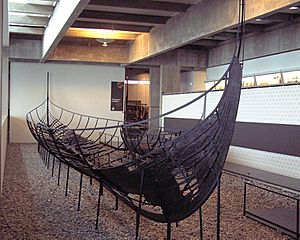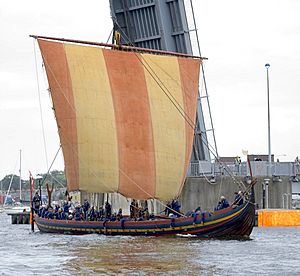Battle of Northam facts for kids
Quick facts for kids Battle of Northam |
|||||||
|---|---|---|---|---|---|---|---|
| Part of Norman Conquest of England | |||||||
|
|||||||
| Belligerents | |||||||
| Anglo-Saxons | Normans | ||||||
| Commanders and leaders | |||||||
| Godwin, Edmund | Brian of Brittany William De Vauville |
||||||
| Strength | |||||||
| unknown | unknown | ||||||
| Casualties and losses | |||||||
| 1,700 | unknown, lower | ||||||
The Battle of Northam, sometimes known as the Two Battles of Northam, were fought around Northam Parish, Devon in 1069 between a Norman force led by Brian of Brittany and an Anglo–Saxon army commanded by Godwin and Edmund, two sons of the late English king Harold Godwinson. The Normans inflicted heavy casualties on the Saxons and forced them to retreat from Devon.
Contents
Background
On 14 October 1066, the English king, Harold Godwinson, was defeated and killed at the Battle of Hastings by the Duke of Normandy (known as William the Conqueror) and his forces. Although William had won the battle, it took several years for the Normans to consolidate their rule over England, with William facing a series of rebellions and border skirmishes in Dover, Exeter, Hereford, Nottingham, Durham, York and Peterborough. The problem for William was that he simply did not have the troops to enforce his will north of the Humber or in the West of England. The lack of overall control by William empowered many members of Harold's family to continue the fight against Norman rule. This included the likes of Harold's mother Gytha and his sons Godwin, Edmund and Magnus by Harold's wife Edith.
Prelude
In 1067, unrest in the Welsh Marches and Dover had been suppressed without the intervention of William, now King of England. At the beginning of 1068 dissent in the West became more serious, with the people of Exeter rebelling. The king, possibly because Harold's mother Gytha and family were based there, led an army, that included some English, to besiege the walled city of Exeter. After an 18-day siege the city surrendered and Gytha fled. The Anglo-Saxon Chronicle for 1067 said:
This year Harold's mother, Githa, and the wives of many good men with her, went to the Steep Holmes, and there abode some time; and afterwards went from thence over sea to St. Omer's.
While William was besieging Exeter, an invasion fleet led by Harold's three sons, Godwin, Edmund and Magnus, set sail from Ireland and raided southwest England. The fleet of 52 ships was provided by Diarmait, the High King of Ireland, who had previously helped their father, in 1052. By the time they arrived in Devon, William had gone, although he left a large force to defend the area. The defending force was headed by Eadnoth the Staller, who engaged the brothers at Bleadon in Somerset. The exact outcome of the battle is unknown, but Eadnoth was killed, and the Saxons retreated to their ships. Magnus is not mentioned in any of the contemporary records after this battle, so it is not clear what happened to him. After the Battle of Bleadon the Saxons continued to raid the coast of Devon and Cornwall, before eventually returning to Ireland with their plunder.
Battles
In June 1069, Godwin and Edmund returned with their army with over sixty ships. The landing was at Appledore, a small village on the north Devon coast. They advanced to Northam and began raiding the area. It is likely that this was the site of the first battle of the day, as the Norman army, now under command of the king’s second cousin, Brian of Brittany, and the noble William De Vauville quickly arrived in the area and attacked the Saxons.
After this came Harold’s sons from Ireland, at Midsummer, with 64 ships into the mouth of the Taw, and there heedlessly landed; and Earl Brian [Brian of Brittany] came against them unawares with no small band, and fought against them.
The exact size of both armies is unknown. However, Brian was supported by a troop of Breton knights, with other sources suggesting that William De Vauville was the Sheriff of Devon.The sheriff was responsible for calling out the Anglo-Saxon militia (known as the Fyrd). This would explain how the Normans had a superior force to that of Godwin and Edmund.
The scattered raiders were quickly pushed back to Appledore, where they joined up with the rest of their army. There they discovered that their ships were not ready to sail as the tide was out. The troops were forced to stay and fight the second battle of the day while they waited for high tide.
For many hours the Normans launched repeated attacks against the Anglo–Saxon shield wall, in almost exactly the same way the early stages of the Battle of Hastings had played out. The Saxon line never broke, but they suffered heavy casualties. As night came, the tide finally returned, and the Saxons escaped to sea, ending the battle.
Aftermath

According to William of Jumièges, the Saxons had taken 1,700 casualties. The Anglo–Saxon Chronicle claimed that the survivors fled to their ships, having lost their best men. None of the brothers were reported as killed and it is thought that they returned to Ireland, where Diarmat told them he either could not or would not supply them with more forces. The brothers moved on to Denmark, possibly hoping to receive new help from King Sweyn II Estridsson. However, that help clearly must not have come, since the brothers soon disappeared from history. The chronicler Orderic Vitalis wrote that after the battle and the surrender of Exeter with favourable terms, a castle was established and William the Conqueror led his army into Cornwall, where he 'put down every disturbance that came to his attention'. The Battle of Northam marks the end of the attempts of Harold’s successors to reclaim the throne of England.



